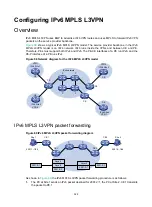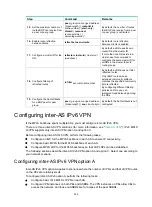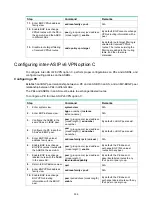
328
Step Command
Remarks
2.
Create an OSPFv3 process
for a VPN instance and enter
OSPFv3 view.
ospfv3
[
process-id
]
vpn-instance
vpn-instance-name
Perform this configuration on the
PE.
The maximum number of OSPFv3
processes for a VPN instance is
50.
Deleting a VPN instance also
deletes all related OSPFv3
processes.
3.
Set the router ID.
router-id
router-id
N/A
4.
(Optional.) Set an OSPFv3
domain ID.
domain-id
{
domain-id
[
secondary
] |
null
}
The default domain ID is 0.
Perform this configuration on the
PE.
When you redistribute OSPFv3
routes into BGP, BGP adds the
primary domain ID to the
redistributed BGP VPNv6 routes
as a BGP extended community
attribute.
You can configure the same
domain ID for different OSPFv3
processes.
You must configure the same
domain ID for all OSPFv3
processes of the same VPN to
ensure correct route
advertisement.
5.
(Optional.) Configure the
type code of an OSPFv3
extended community
attribute.
ext-community-type
{
domain-id
type-code1
|
route-type
type-code2
|
router-id
type-code3
}
By default, the type codes for
domain ID, route type, and router
ID are hexadecimal numbers
0005, 0306, and 0107,
respectively.
Perform this configuration on the
PE.






























